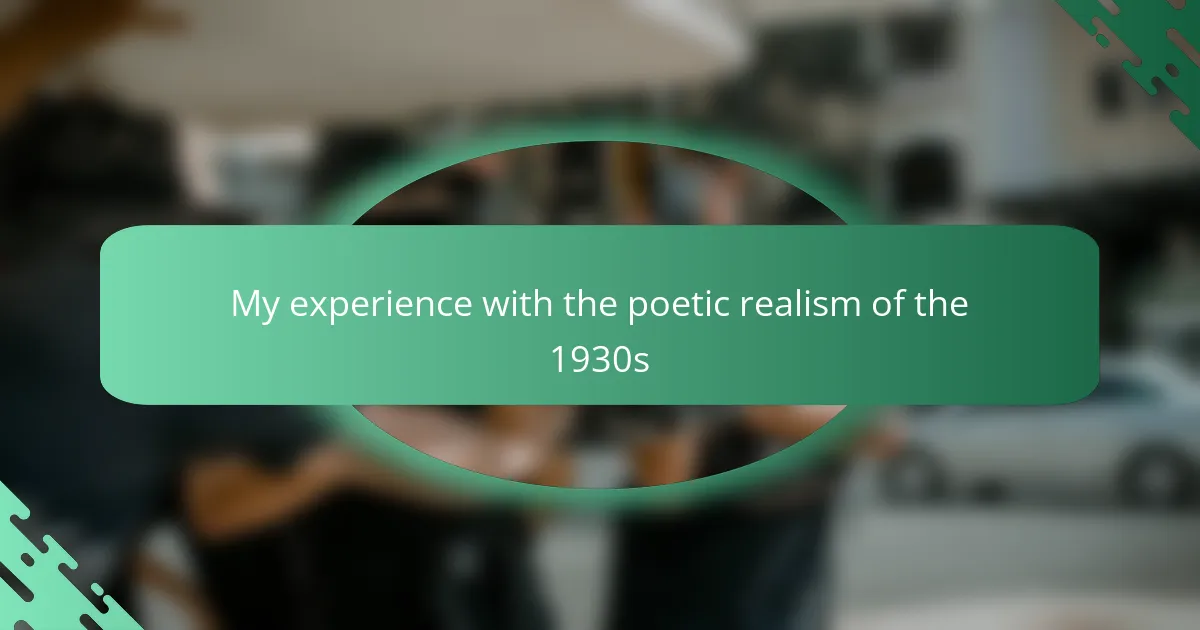Key takeaways
- French poetic realism, emerging in the 1930s, combines realistic narratives with lyrical, melancholic imagery, focusing on working-class struggles.
- Key films like “Port of Shadows” and “The Human Beast” showcase emotional depth and complex characters, often exploring themes of love, despair, and societal constraints.
- The movement influenced future filmmakers, inspiring cinematic explorations of human emotion and societal issues, notable in later works by directors like Godard and Truffaut.
- The artistic cinematography and thematic content create a unique viewing experience that resonates with audiences, reflecting the bittersweet nature of life.
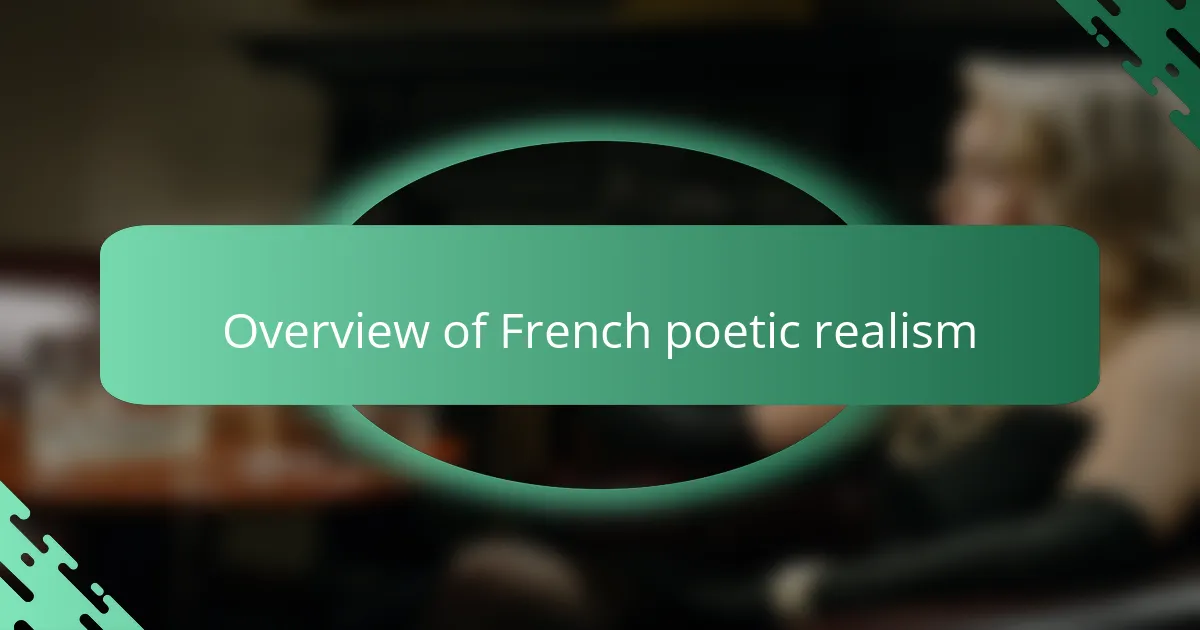
Overview of French poetic realism
French poetic realism emerged in the 1930s as a unique film movement that beautifully captured the complexities of everyday life with a sense of melancholy and romanticism. I remember the first time I watched a classic from this era; the atmosphere was so rich with emotional nuance that it made me reflect on the struggles and dreams of the characters, often portrayed as working-class individuals facing harsh realities. The films often blended lyrical imagery with gritty realism, creating a poignant contrast that resonated deeply with audiences.
The movement is characterized by its focus on poetic narrative, expressive cinematography, and the exploration of themes such as love, loss, and social despair. I found it fascinating how films like “Port of Shadows” and “The Grand Illusion” not only entertained but also stirred introspection about society and the human condition. Each frame felt like a brushstroke on a canvas of raw emotion, leaving a lasting impact.
| Feature | Poetic Realism |
|---|---|
| Themes | Love, loss, and social struggles |
| Cinematography | Lyrical imagery with a gritty touch |
| Character Focus | Working-class and marginal figures |
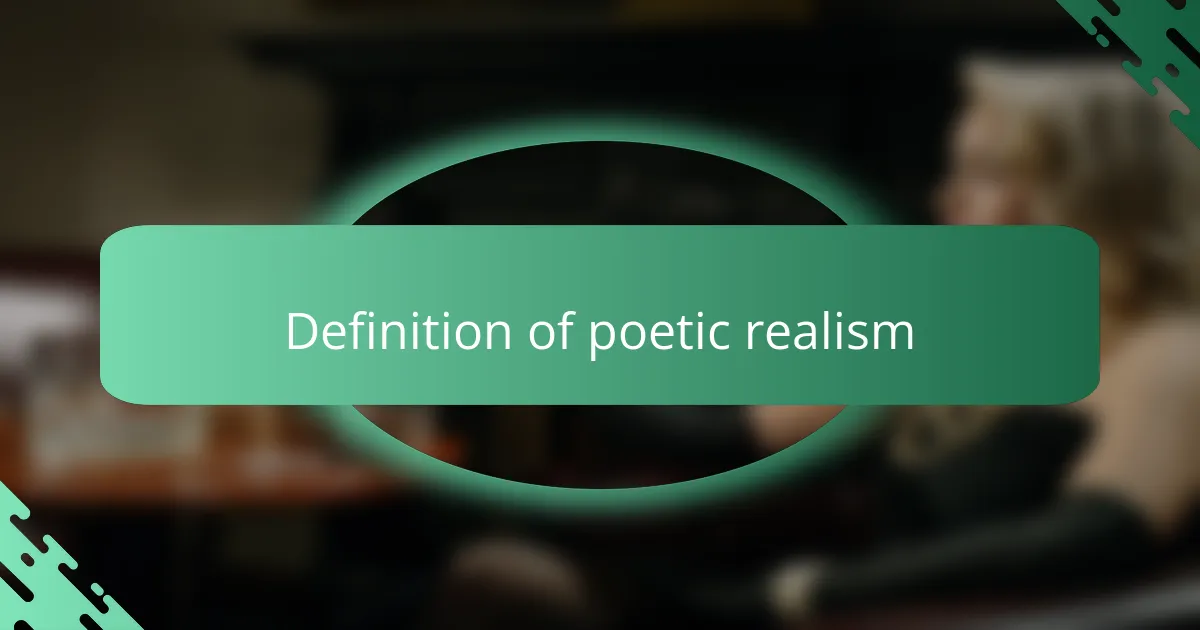
Definition of poetic realism
Poetic realism is a cinematic movement that emerged in France during the 1930s, characterized by its blend of realistic narratives and lyrical, often melancholic, imagery. In my experience, watching films from this era, like “La Belle Équipe” or “Le Quai des Brumes,” allowed me to appreciate how directors fused the harshness of reality with poetic elements. It creates an emotional resonance, where the characters’ struggles are depicted with a sense of beauty and tragic inevitability.
- Focus on the working class: The protagonists often belong to the lower classes, portraying their dreams and struggles against societal constraints.
- Melancholic themes: Many stories convey a sense of nostalgia and despair, often ending in tragedy or unfulfilled desires.
- Artistic cinematography: The use of chiaroscuro lighting and expressive camera angles enhances the emotional depth of the narratives.
- Blending of genres: Poetic realism mixes elements of drama, romance, and sometimes even fantasy, providing a unique viewing experience.
- Influence on later filmmakers: Directors like Jean-Luc Godard and François Truffaut drew inspiration from this movement, showing its lasting impact on cinema.
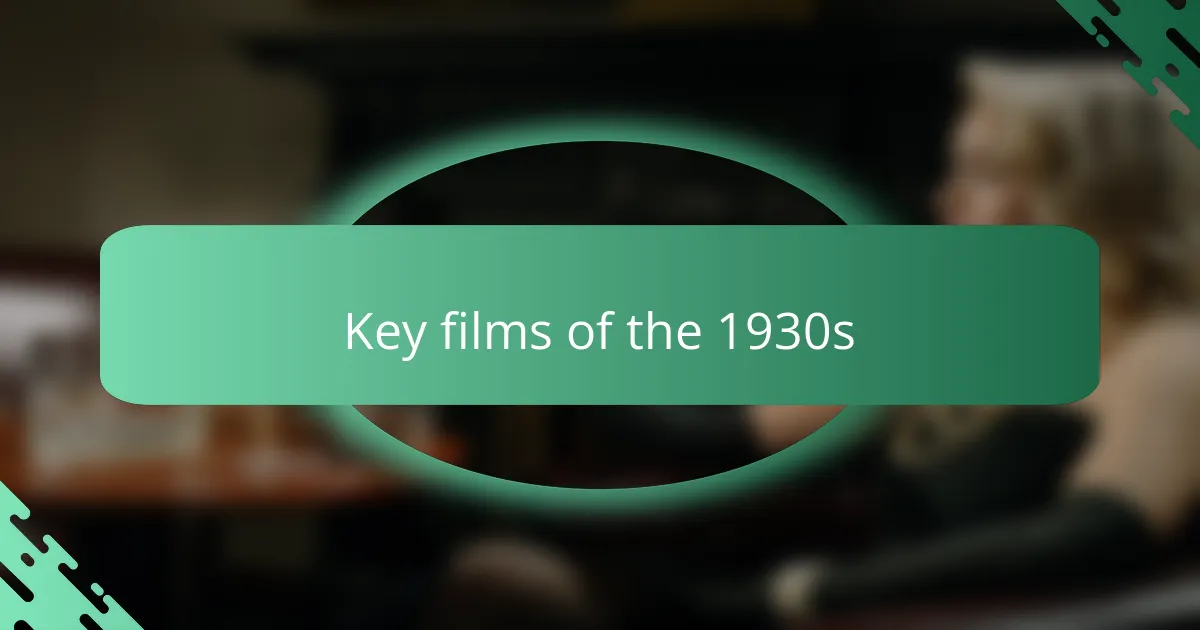
Key films of the 1930s
The 1930s were a groundbreaking era for French cinema, marked by the emergence of poetic realism, which beautifully blended everyday life with artistic expression. I remember watching “Le Quai des Brumes” (“Port of Shadows”), directed by Marcel Carné, for the first time; its melancholic atmosphere and unforgettable characters left a profound impact on me, reminding me of the fragility of dreams in the face of harsh realities.
As I delved deeper into this cinematic movement, I was also captivated by the vivid storytelling in “La Bête Humaine” (“The Human Beast”), which showcased the darker sides of human nature through a gripping narrative. Each film of this era invites viewers to reflect on their own lives, drawing emotion and thought from the struggles and desires depicted on screen.
Here are some key films that truly showcase the essence of poetic realism from the 1930s:
- Le Quai des Brumes (Port of Shadows), 1938 – A haunting tale of love and despair set against a foggy port.
- La Bête Humaine (The Human Beast), 1938 – A gripping exploration of obsession and morality, highlighted by Jean Gabin’s remarkable performance.
- Le Jour Se Lève (Daybreak), 1939 – A deeply emotional film that examines fate and regret, offering a poignant look at choices and their consequences.
- Pépé le Moko, 1937 – A film that encapsulates the essence of longing and entrapment within one’s environment, set in the vibrant Algiers.
These films not only captured the spirit of their time but also continue to resonate with audiences today, making them timeless treasures in the world of cinema.
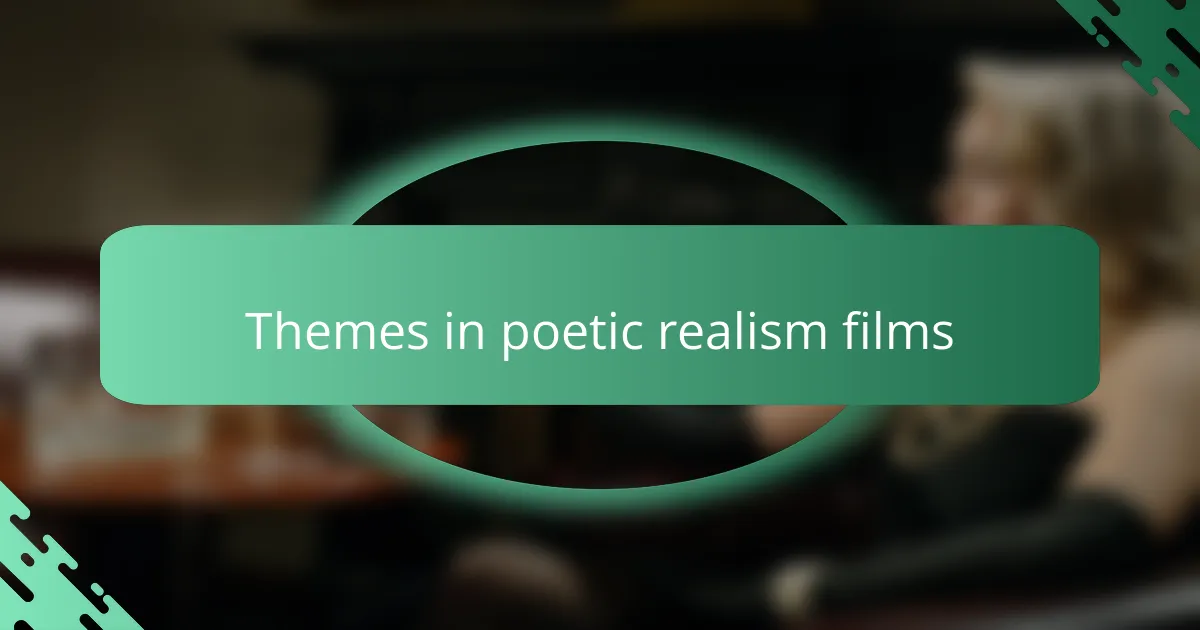
Themes in poetic realism films
Poetic realism films often explore themes of love, despair, and the harsh realities of life, all intricately woven together to create a deeply emotional experience. I remember the first time I watched “Hotel du Nord” and felt enveloped by the characters’ struggles and desires. It was like a mirror reflecting the bittersweet nature of existence, something I hadn’t truly considered before.
These themes resonate on a personal level, allowing viewers to connect with the characters’ emotions. The contrasting beauty and tragedy in their stories often evoke a sense of nostalgia and longing. The following themes are particularly prevalent in this genre:
- The inevitability of fate
- The tension between dreams and reality
- Social class disparities
- The complexity of human relationships
- The influence of the urban landscape on personal lives
These elements create a tapestry of human experience that remains relevant, drawing us in and prompting reflection on our own lives.
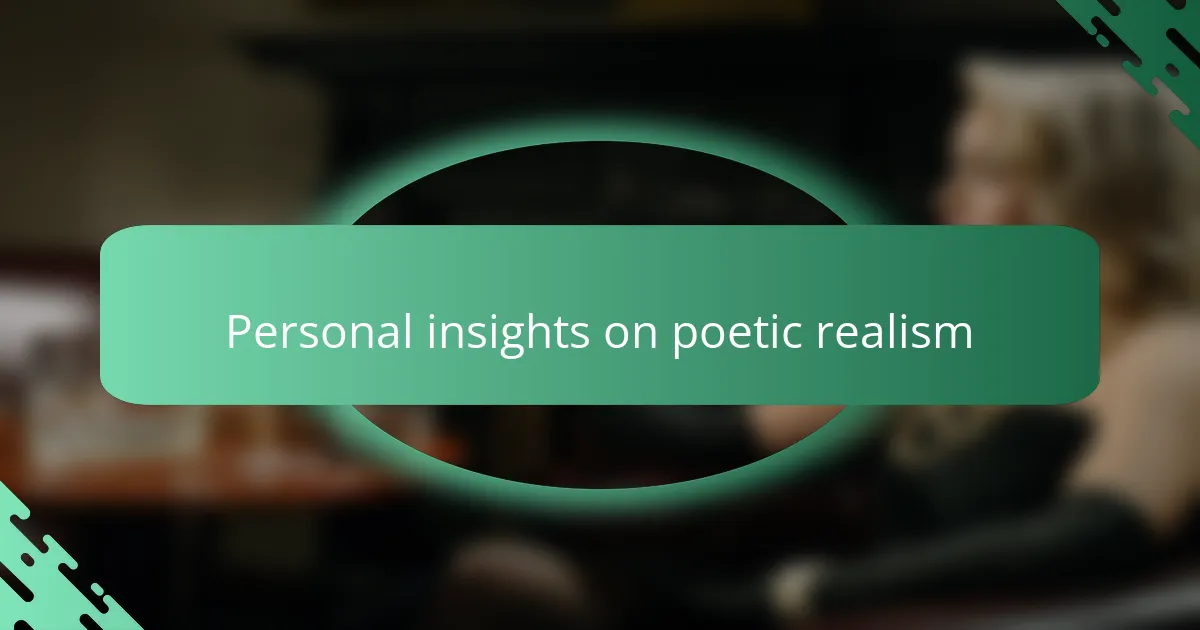
Personal insights on poetic realism
When I reflect on the poetic realism of the 1930s, I can’t help but recall the way these films captured the essence of life with stark beauty and melancholy. I remember the first time I watched “Port of Shadows” by Marcel Carné; the gloomy atmosphere and the captivating performances drew me into a world where hope and despair coexist. The characters felt so real and relatable, and their stories resonated deeply with my own experiences of longing and loss.
This cinematic movement beautifully blended the everyday struggles of ordinary people with artistic expression. The tension between idealism and realism struck a chord with me, reminding me of my own life challenges. I often find myself contemplating how dreams and harsh realities intertwine, just as the films did with their hauntingly beautiful imagery and poignant narratives.
Here’s a comparison table that highlights key features of poetic realism versus traditional realism:
| Poetic Realism | Traditional Realism |
|---|---|
| Focuses on emotions and mood | Emphasizes factual accuracy and mundane details |
| Often features doomed love stories | Tends to avoid melodrama and sentimentality |
| Utilizes visual aesthetics for emotional impact | Concentrates on straightforward storytelling |
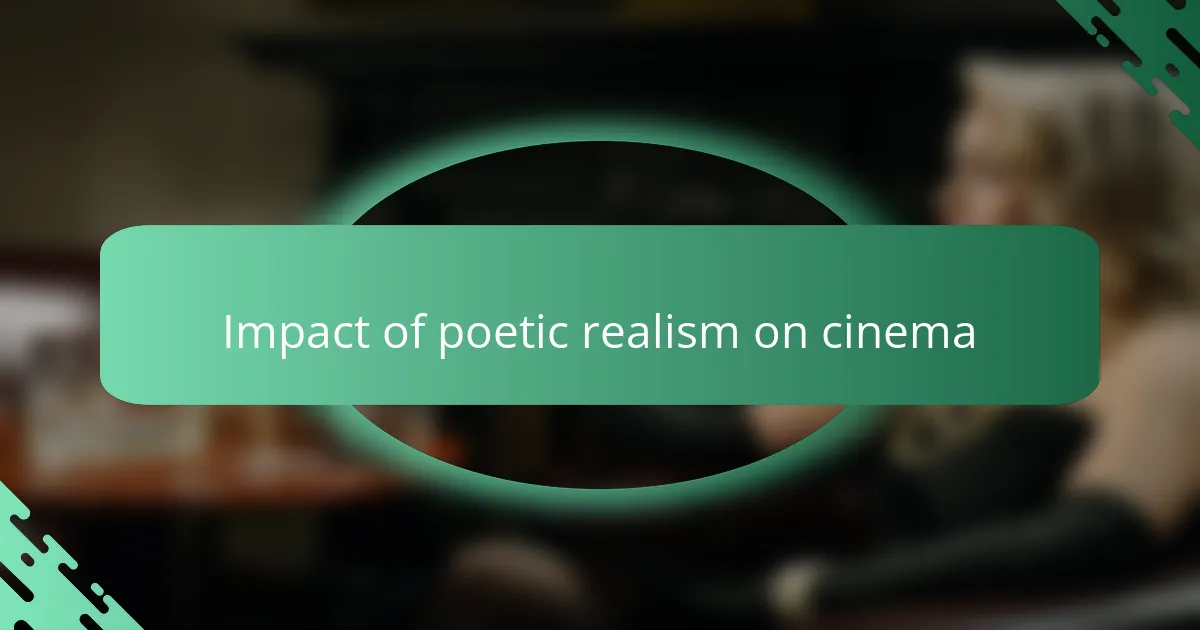
Impact of poetic realism on cinema
Poetic realism profoundly impacted the landscape of cinema, particularly in how stories were portrayed. I’ve always felt that the blend of everyday struggles with an almost lyrical quality in these films stirred a unique emotional connection. For instance, movies like “Le Jour se Lève” showcase characters trapped by their circumstances, yet they maintain a dreamlike quality that resonates deeply with viewers.
This movement also paved the way for future filmmakers, inspiring them to explore the complexities of human emotions and societal issues. Reflecting on classics like “Port of Shadows,” I remember being struck by how the melancholic beauty of the visuals paralleled the characters’ tragic lives. It’s this balance of beauty and despair that defines the essence of poetic realism.
| Aspect | Poetic Realism |
|---|---|
| Emotional Depth | Focuses on tragic romance and existential themes. |
| Visual Style | Blends gritty realism with artistic cinematography. |
| Character Development | Complex characters navigating their bleak realities. |
